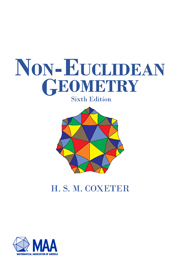Book contents
- Frontmatter
- PREFACE TO THE SIXTH EDITION
- Contents
- I THE HISTORICAL DEVELOPMENT OF NON-EUCLIDEAN GEOMETRY
- II REAL PROJECTIVE GEOMETRY: FOUNDATIONS
- III REAL PROJECTIVE GEOMETRY: POLARITIES, CONICS AND QUADRICS
- IV HOMOGENEOUS COORDINATES
- V ELLIPTIC GEOMETRY IN ONE DIMENSION
- VI ELLIPTIC GEOMETRY IN TWO DIMENSIONS
- VII ELLIPTIC GEOMETRY IN THREE DIMENSIONS
- VIII DESCRIPTIVE GEOMETRY
- IX EUCLIDEAN AND HYPERBOLIC GEOMETRY
- X HYPERBOLIC GEOMETRY IN TWO DIMENSIONS
- XI CIRCLES AND TRIANGLES
- XII THE USE OF A GENERAL TRIANGLE OF REFERENCE
- XIII AREA
- XIV EUCLIDEAN MODELS
- XV CONCLUDING REMARKS
- APPENDIX: ANGLES AND ARCS IN THE HYPERBOLIC PLANE
- BIBLIOGRAPHY
- INDEX
II - REAL PROJECTIVE GEOMETRY: FOUNDATIONS
- Frontmatter
- PREFACE TO THE SIXTH EDITION
- Contents
- I THE HISTORICAL DEVELOPMENT OF NON-EUCLIDEAN GEOMETRY
- II REAL PROJECTIVE GEOMETRY: FOUNDATIONS
- III REAL PROJECTIVE GEOMETRY: POLARITIES, CONICS AND QUADRICS
- IV HOMOGENEOUS COORDINATES
- V ELLIPTIC GEOMETRY IN ONE DIMENSION
- VI ELLIPTIC GEOMETRY IN TWO DIMENSIONS
- VII ELLIPTIC GEOMETRY IN THREE DIMENSIONS
- VIII DESCRIPTIVE GEOMETRY
- IX EUCLIDEAN AND HYPERBOLIC GEOMETRY
- X HYPERBOLIC GEOMETRY IN TWO DIMENSIONS
- XI CIRCLES AND TRIANGLES
- XII THE USE OF A GENERAL TRIANGLE OF REFERENCE
- XIII AREA
- XIV EUCLIDEAN MODELS
- XV CONCLUDING REMARKS
- APPENDIX: ANGLES AND ARCS IN THE HYPERBOLIC PLANE
- BIBLIOGRAPHY
- INDEX
Summary
Definitions and axioms. In any geometry, logically developed, each definition of an entity or relation involves other entities and relations; therefore certain particular entities and relations must remain undefined. Similarly, the proof of each proposition uses other propositions; therefore certain particular propositions must remain unproved; these are the axioms. We take for granted the machinery of logical deduction, and the primitive concept of a class (or “set of all”).
Unless the contrary is stated, the word correspondence will be used in the sense of one-to-one correspondence. Thus a set of entities is said to correspond to another set if every entity in each set is associated with a unique entity in the other set. In geometry the entities are usually points or lines, and the set of entities is called a figure. Thus we speak of a correspondence between two figures. It is often convenient to regard the correspondence as an operation which changes the first figure into the second. (Familiar instances are rotation, reflection, inversion, and reciprocation.) The general technique for discussing correspondences belongs properly to the theory of groups; but the following outline will suffice for our purposes.
- Type
- Chapter
- Information
- Non-Euclidean Geometry , pp. 16 - 47Publisher: Mathematical Association of AmericaPrint publication year: 1998



